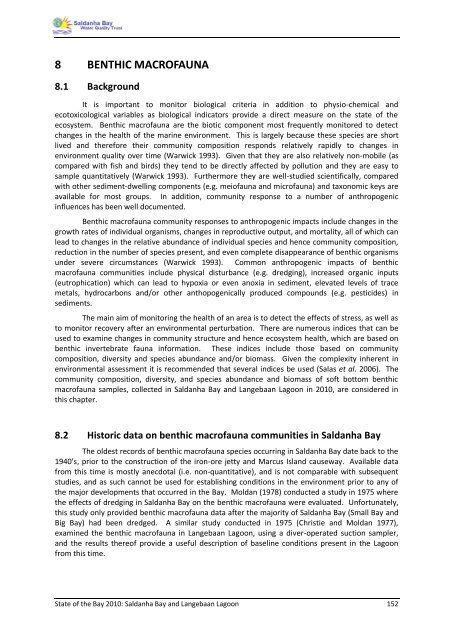State of the Bay Report 2010-Final - Anchor Environmental
State of the Bay Report 2010-Final - Anchor Environmental
State of the Bay Report 2010-Final - Anchor Environmental
You also want an ePaper? Increase the reach of your titles
YUMPU automatically turns print PDFs into web optimized ePapers that Google loves.
8 BENTHIC MACROFAUNA<br />
8.1 Background<br />
It is important to monitor biological criteria in addition to physio-chemical and<br />
ecotoxicological variables as biological indicators provide a direct measure on <strong>the</strong> state <strong>of</strong> <strong>the</strong><br />
ecosystem. Benthic macr<strong>of</strong>auna are <strong>the</strong> biotic component most frequently monitored to detect<br />
changes in <strong>the</strong> health <strong>of</strong> <strong>the</strong> marine environment. This is largely because <strong>the</strong>se species are short<br />
lived and <strong>the</strong>refore <strong>the</strong>ir community composition responds relatively rapidly to changes in<br />
environment quality over time (Warwick 1993). Given that <strong>the</strong>y are also relatively non-mobile (as<br />
compared with fish and birds) <strong>the</strong>y tend to be directly affected by pollution and <strong>the</strong>y are easy to<br />
sample quantitatively (Warwick 1993). Fur<strong>the</strong>rmore <strong>the</strong>y are well-studied scientifically, compared<br />
with o<strong>the</strong>r sediment-dwelling components (e.g. mei<strong>of</strong>auna and micr<strong>of</strong>auna) and taxonomic keys are<br />
available for most groups. In addition, community response to a number <strong>of</strong> anthropogenic<br />
influences has been well documented.<br />
Benthic macr<strong>of</strong>auna community responses to anthropogenic impacts include changes in <strong>the</strong><br />
growth rates <strong>of</strong> individual organisms, changes in reproductive output, and mortality, all <strong>of</strong> which can<br />
lead to changes in <strong>the</strong> relative abundance <strong>of</strong> individual species and hence community composition,<br />
reduction in <strong>the</strong> number <strong>of</strong> species present, and even complete disappearance <strong>of</strong> benthic organisms<br />
under severe circumstances (Warwick 1993). Common anthropogenic impacts <strong>of</strong> benthic<br />
macr<strong>of</strong>auna communities include physical disturbance (e.g. dredging), increased organic inputs<br />
(eutrophication) which can lead to hypoxia or even anoxia in sediment, elevated levels <strong>of</strong> trace<br />
metals, hydrocarbons and/or o<strong>the</strong>r anthopogenically produced compounds (e.g. pesticides) in<br />
sediments.<br />
The main aim <strong>of</strong> monitoring <strong>the</strong> health <strong>of</strong> an area is to detect <strong>the</strong> effects <strong>of</strong> stress, as well as<br />
to monitor recovery after an environmental perturbation. There are numerous indices that can be<br />
used to examine changes in community structure and hence ecosystem health, which are based on<br />
benthic invertebrate fauna information. These indices include those based on community<br />
composition, diversity and species abundance and/or biomass. Given <strong>the</strong> complexity inherent in<br />
environmental assessment it is recommended that several indices be used (Salas et al. 2006). The<br />
community composition, diversity, and species abundance and biomass <strong>of</strong> s<strong>of</strong>t bottom benthic<br />
macr<strong>of</strong>auna samples, collected in Saldanha <strong>Bay</strong> and Langebaan Lagoon in <strong>2010</strong>, are considered in<br />
this chapter.<br />
8.2 Historic data on benthic macr<strong>of</strong>auna communities in Saldanha <strong>Bay</strong><br />
The oldest records <strong>of</strong> benthic macr<strong>of</strong>auna species occurring in Saldanha <strong>Bay</strong> date back to <strong>the</strong><br />
1940’s, prior to <strong>the</strong> construction <strong>of</strong> <strong>the</strong> iron-ore jetty and Marcus Island causeway. Available data<br />
from this time is mostly anecdotal (i.e. non-quantitative), and is not comparable with subsequent<br />
studies, and as such cannot be used for establishing conditions in <strong>the</strong> environment prior to any <strong>of</strong><br />
<strong>the</strong> major developments that occurred in <strong>the</strong> <strong>Bay</strong>. Moldan (1978) conducted a study in 1975 where<br />
<strong>the</strong> effects <strong>of</strong> dredging in Saldanha <strong>Bay</strong> on <strong>the</strong> benthic macr<strong>of</strong>auna were evaluated. Unfortunately,<br />
this study only provided benthic macr<strong>of</strong>auna data after <strong>the</strong> majority <strong>of</strong> Saldanha <strong>Bay</strong> (Small <strong>Bay</strong> and<br />
Big <strong>Bay</strong>) had been dredged. A similar study conducted in 1975 (Christie and Moldan 1977),<br />
examined <strong>the</strong> benthic macr<strong>of</strong>auna in Langebaan Lagoon, using a diver-operated suction sampler,<br />
and <strong>the</strong> results <strong>the</strong>re<strong>of</strong> provide a useful description <strong>of</strong> baseline conditions present in <strong>the</strong> Lagoon<br />
from this time.<br />
<strong>State</strong> <strong>of</strong> <strong>the</strong> <strong>Bay</strong> <strong>2010</strong>: Saldanha <strong>Bay</strong> and Langebaan Lagoon 152

















